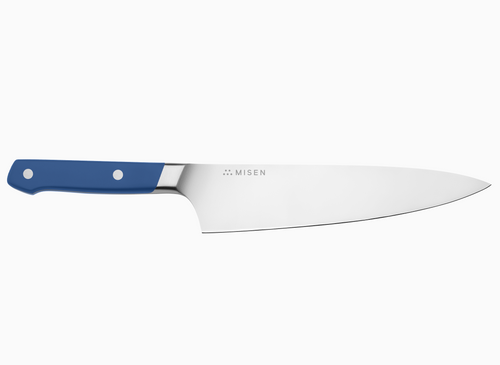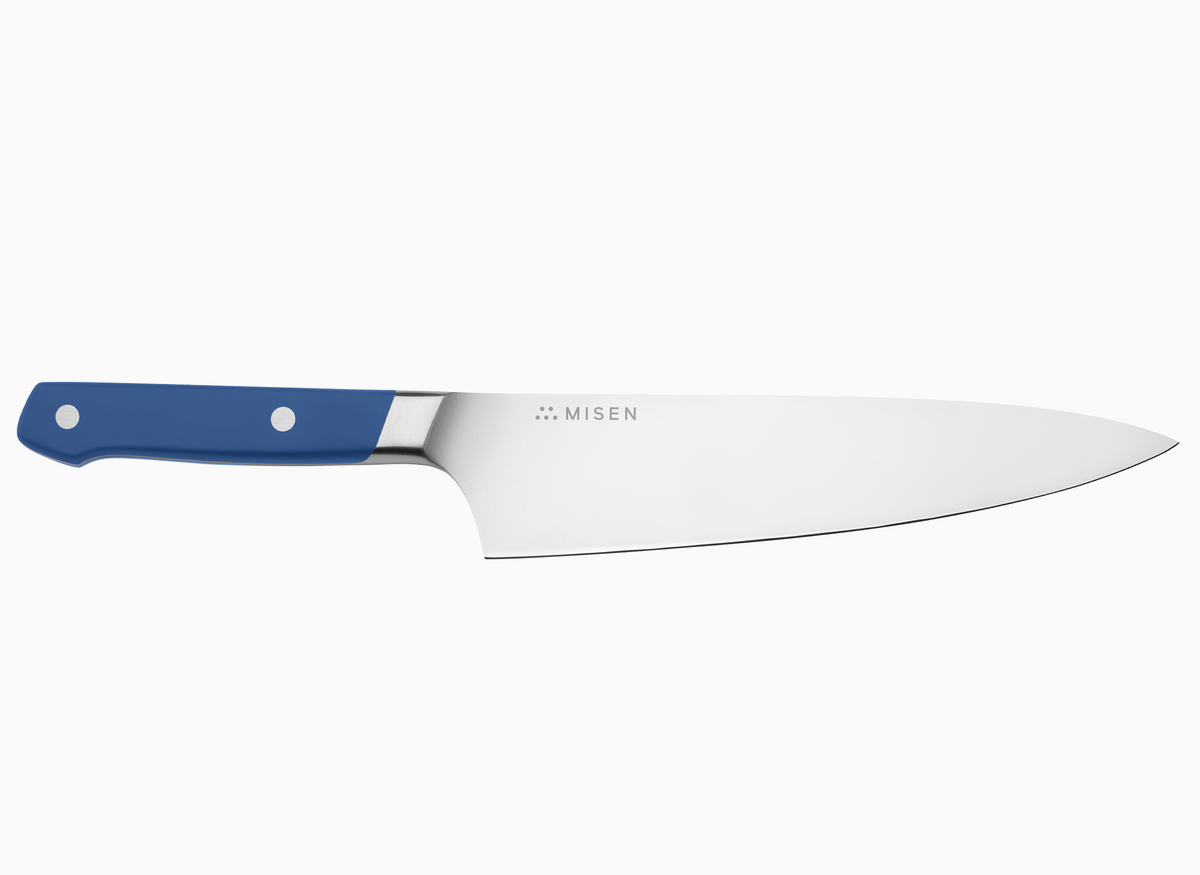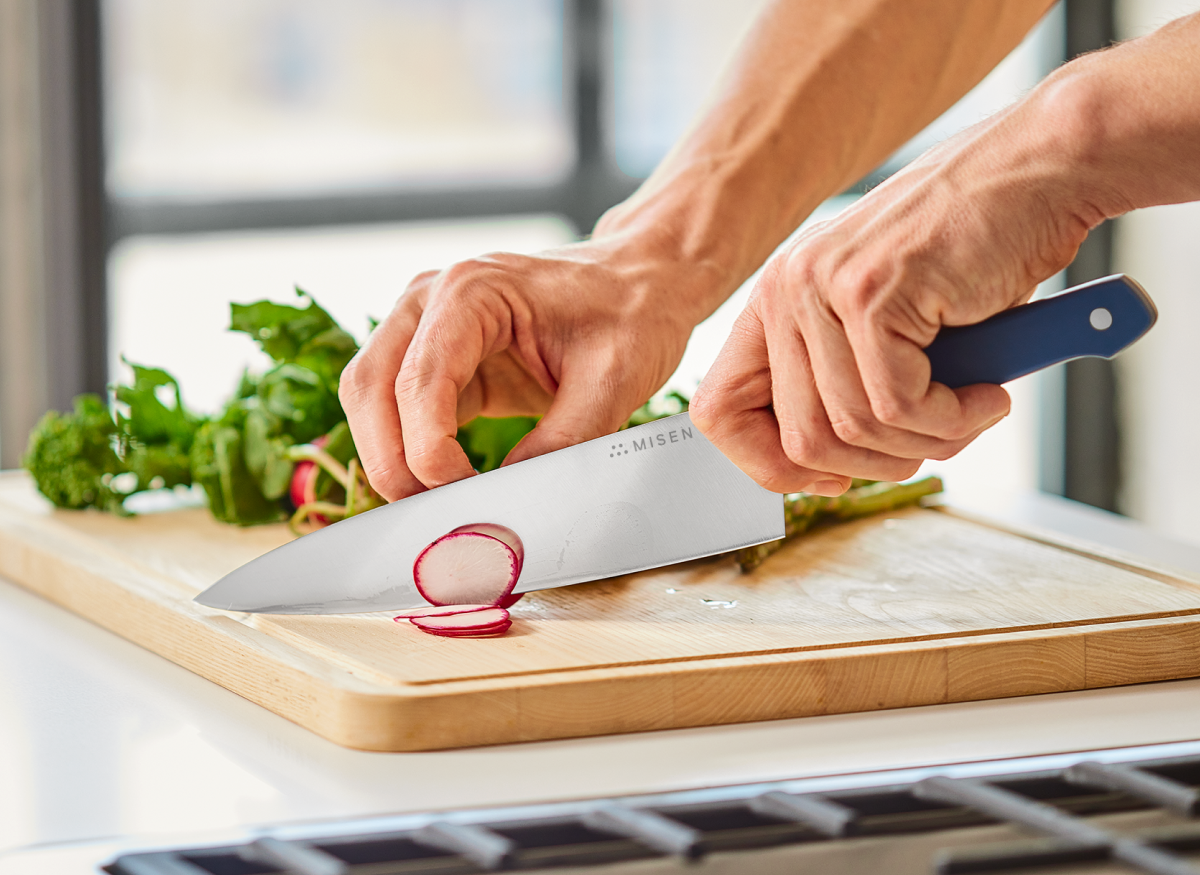Finding the Right Knife Handle Material for You
 The material used to make a knife handle plays a big part in how comfortable, functional, and easy it is to use in the kitchen.
The material used to make a knife handle plays a big part in how comfortable, functional, and easy it is to use in the kitchen.
- The most important aspect to look for in a good knife handle is a comfortable grip.
- Knife handles are usually either made with natural or synthetic material.
- Natural material is more traditional, while synthetic material offers a greater variety of shapes and colors.
The nature of handheld items — pencils, umbrellas, mobile phones — is that their primary function lies outside of our hands. The portion in our palm remains concealed and for the most part, ignored.
This is also true in the case of kitchen knives, where the focal point is the blade (which is also the part farthest from our actual hand placement). Countless articles and aficionados debate the best material, shape, length, and make of every knife blade.
Knife handles, on the other hand, don't get as much attention. But when you think of all the time you spend actually holding a knife (for most home cooks, that’s every time you’re in the kitchen), the handle becomes an increasingly important feature.
Making up nearly half of the entire knife, the handle is what dictates the different grips, durability, and overall comfort of the tool. So whether you’re slicing an apple or preparing a multi-course meal, it’s important to have a knife handle that’s the right fit.
Knife Handle Anatomy
While knife handles are constructed as one smooth piece, they’re actually divided into four anatomical parts.
Starting from the back of the knife, the end opposite the blade tip, you’ll find the handle butt. This is the bottom or terminal end of the knife’s handle, and can be rounded, straight, or angular.
Oftentimes, the knife handle features a soft, jutting edge that, when held, rests right beside your pinky finger. This is called a handle guard and it’s designed to give a better grip and prevent the knife from slipping.
The next part is the tang, which is actually the part of the blade that extends into the handle. How far the blade extends depends on whether it’s a full tang or partial tang — a full tang runs the entire length of the knife and handle, while partial tang only runs through a portion of the handle. The purpose of the tang is to give the knife added stability and weight.
Rivets are the metal pieces, usually screws or pins that secure the tang to the handle. Knives typically have three rivets, which can be visible or hidden, depending on the design.
Scales are the largest part of the handle, and are often what one would consider the entire knife handle. Actually, they are the two identical halves that form the body of the handle, and are attached to either side of the tang with rivets. Scales come in many different materials and are what we are actually referring to when discussing knife handle material (the parts aside from the scale are usually the same material as the blade).
Knife handle material is just as varied as knife blade material — if not more so. For the most part, the many materials can be classified into one of two categories: natural or synthetic.
Natural Materials
 Some types of wood, especially if they’re very soft or porous, require a stabilization process for increased density and durability before they can be used on a knife handle.
Some types of wood, especially if they’re very soft or porous, require a stabilization process for increased density and durability before they can be used on a knife handle.
Natural materials, such as wood, metal, and bone, are considered the most traditional and beautiful in form. However, their organic nature does get affected by changes in heat and humidity, and requires more maintenance.
Wood
Wood is one of the oldest, most popular types of knife handle material. Its strong composition and textured grain give the knife handle a good grip, durable composition, and aesthetic appeal.
As compared to all other natural materials, wood offers the most variety. Not only can it be easily carved into different shapes, wood knife handles are also available in many different species. The most common ones are African blackwood, desert ironwood, rosewood, cocobolo, and walnut — these are types of wood that are both solid and stable (they don't expand or contract in extreme temperatures).
Many brands prefer to work with wood composites (i.e., Pakkawood for Shun and Richlite for Wüsthof). The wood that is commonly used in composites is referred to as “burl,” which indicates that the wood comes from a tree with a round knotted growth. Common types are maple, black ash, box elder, and pine cone burl.
The wood composites used in knife handles have also been specially engineered to include plastic and other synthetic polymers in order for them to withstand wet environments and constant usage. These handles usually have a polished, glossy appearance with a deep, rich coloring.
Resin-Stabilized Material
Sometimes, natural materials are stabilized to make them better for knife handles. The stabilization process injects resin into any of the existing pores or cracks, and then compresses the material using high heat and pressure. The result is a stabilized material that now offers increased density and durability without greatly changing the original appearance. This is commonly done with wood or bone handles, although the later is mostly used in pocket knives, custom knives, or collectibles.
Metal
Metal is another natural choice for knife handles, due to its durability, strength, and easy maintenance. A metal handle’s smooth surface can make it prone to slipping, especially when wielded by a wet hand. However, many knives with metal handles feature a textured designs or a brushed satin finish for better grip.
Similar to blades, the most frequently used metals in knife handles are stainless steel, aluminium, and titanium. Stainless steel is popular for its resistance to rust and corrosion. However, unless the handle has a hollow core, a completely stainless steel knife might be too heavy for the average cook.
Titanium is a lighter metal with low-density, high-strength, and similar corrosion-resistant properties to stainless steel. The titanium used in knives is typically alloyed with aluminium and vanadium, as a way to increase its durability, and can be further finished with anodizing (for color) or bead blasting (for texture).
Aluminum is another low-density, corrosion-resistant metal. In terms of weight, aluminum falls in between stainless steel and titanium — it’s lighter than stainless steel and heavier than titanium. While it’s not as strong as titanium, it’s also not as expensive.
Synthetic Material
 Being highly durable, customizable, and resistant to wear and tear, synthetic knife handles are made for kitchen use.
Being highly durable, customizable, and resistant to wear and tear, synthetic knife handles are made for kitchen use.
Synthetic handles usually come in the form of acrylic, plastic, resin, and other composites. They offer a more polished appearance, are much easier to care for, and come in a wide array of shapes and colors.
Plastic
Plastic is perhaps the most common synthetic knife handle material, thanks to its ready availability, affordability, and easy maintenance. There are an assortment of plastics available with each formulation offering a specific set of properties.
Polypropylene and ABS are two polymers with a high-strength and lightweight construction. They’re often used in kitchen knife handles, as they can be easily molded into a wide assortment of shapes and colors. Polyoxymethylene is another type of plastic that is slightly pricier, but protects against discoloration or color fade.
Perhaps the greatest benefits of plastic are that they can be easily shaped and combined with other materials (i.e. a plastic handle with rubber grip), are relatively affordable, and come in a variety of colors, a good feature to help identify specific knives and prevent cross-contamination.
Thermoplastic Elastomers (TPE)
Thermoplastic elastomers are a combination of polymers, usually plastic and rubber, and often go by a brand name — Dryflex, Laprene, Santoprene, THERMOLAST K, and the like. The most popular TPE is Zytel, a product of DuPont, which is resistant to impact, abrasions, and breakage.
TPE is basically rubberized plastic, combining the benefits of both rubber (grip, texture, and elasticity) and plastic (high strength, lightweight, and available in a variety of colors).
TPEs are preferred for their grip, which is not very slippery even when wet, and are therefore ideal for kitchen use. Plus, since handles made of wood or other natural materials can warp if not cared for correctly, a good knife with a high-density, temperature-resistant TPE handle can make maintenance much easier.
Carbon Fiber
Carbon fiber is a reinforced polymer that contains tightly woven strands of carbon set in resin (hence, carbon fiber). While relatively strong, carbon fiber is not indestructible and may be prone to chips and cracks in cases of high impact. It’s also on the pricier side, as carbon fiber requires a long, laborious production process. However, the material is very lightweight and comes with an attractive woven texture for kitchen knives.
Micarta
Micarta is actually a brand of resin-based laminate that uses linen or paper substrates, with linen being the stronger of the two. Originally intended to provide electrical insulation, Micarta turned out to be a great plastic for kitchen knife handles.
The plastic is created by soaking layers of linen or paper in phenolic resin, and then compressing them using high heat. This produces a strong but light material that is completely stable and almost indestructible.
However, the basic Micarta scale material is very smooth and slippery. And because adding surface texture is quite a long and tedious process, the resulting material can be quite expensive.
G-10
G-10 is also a resin-based laminate that uses fiberglass instead. Similar to Micarta, layers of fiberglass cloth are soaked in phenolic resin and then compressed at high heat. The resulting material is extremely hard and strong, yet still lightweight. G-10 scales are typically black, although many other colors are also available, with a secure grip and rough surface texture.
As the toughest fiberglass resin laminate, that is also water- and temperature-resistant, G-10 handles produce hard-wearing kitchen knives.
All Within Your Grasp
Knives are one of the most useful kitchen tools, and every part of them — from blade tip to handle guard — works together to provide the perfect cuts and slices. While there’s a lot to be said about blades, it’s important that you also consider the handle half of the knife.
Kitchen handles and the material they’re made of play a large part in the comfort, safety, and overall durability of a kitchen knife. Ultimately, as long as a knife is comfortable to hold and the material is durable and heat-resistant, the choice of handle material is truly a matter of preference.








